|
It has been almost a month into the year of 2004. A lot of students, like me, have
already forgotten most of the resolutions we had made on New Year’ eve. However,
it is still not too late because we have a second chance to start afresh with the
celebrations of Chinese New Year on January 22, 2004.
As the most elaborate and important festival in the Chinese culture, the Chinese New
Year is celebrated on the first day of the First Moon of the Lunar Calendar. It is
a time for the Chinese to congratulate each other for passing through another year
and welcome the arrival of a new year. All Chinese holidays stress the significance
of family ties. Among all, the Chinese New Year's Eve dinner is the most important
family occasion of the year.
Lunar Calendar
The Chinese Lunar New Year has the longest chronological history, dating back to 2637
B.C. when Emperor Huang Ti introduced the first cycle of the zodiacs. The Chinese
represent a cyclical concept of time, as opposed to the linear perception of time in
the Gregorian (Western) Calendar. Amazingly, the Lunar Calendar also has 12 months,
each approximately 30 days. The first day of each month (Month is also known as Moon)
is the day of New Moon. Similarly, the 15th day is accompanied by the full moon. A
complete cycle of the Lunar Calendar takes 60 years and is made up of five cycles of 12
months each.
Like all Chinese festivals, the Chinese New Year is determined by the Lunar Calendar.
As a result, the Chinese New Year usually turns out to be some time between mid January
to mid February in the Gregorian Calendar. This year's Chinese New Year is on January 22,
2004. Next year, it will be on Feb 9, 2005.
Chinese Horoscope
The Chinese astrology is based upon the Chinese Lunar Calendar. Similar to the Western
astrology, the Chinese astrology uses 12 different signs to define basic categories of human
beings, using the person's birth date as the basis. While the Western zodiac is monthly, the
Chinese zodiacs are yearly.
The origins of the 12 animals in the Chinese zodiacs are unclear. However, one of the most
popular and interesting legends claims that the Jade Emperor, the supreme Taoist deity,
organized a race to determine who is going to be the head of the cycle of years. The first 12
animals to cross the selected river would represent the 12 cyclical orders of years on the Lunar
Calendar.
All the animals gathered at the riverbank and got ready for the race. Out of generosity, the Ox
offered to let two poor swimmers, the Cat and the Rat, to ride on its back during the race. As
soon as the race had started, the Rat pushed the Cat into the river and stayed at the Ox's ear
throughout the rest of the race. Just right before the Ox was about to land as the winner of the
race, the Rat jumped ashore and stole the first place from his carrier. The order of arrivals of
the animals formed the zodiac system, as shown below.
The Chinese believe that the ruling animal of the year in which a person is born has a profound
influence on his personality. Similar to the Western horoscopes, the Chinese zodiac signs are used
in Feng Shui as a tool to predict the future of a person. Click below on your sign for your Chinese
horoscope.
horoscope chart
The animal signs also serve as a useful social function for determining people's age without asking
them directly. By knowing the zodiac sign of a person, and with a bit of common sense, we can deduce
his/her exact age.
celebrations
Preparations
Traditionally, the celebrations of Chinese New Year last 15 days. However, people tend to start
preparing as early as a month before Chinese New Year. The Chinese clean their houses and get
themselves haircuts, as a sign of farewell to the past year. They also buy presents, food, new
clothing, and decorations and look forward to the New Year.
There are a few superstitious rituals that the Chinese do in preparation to welcome Chinese New Year.
It is believe that, on the 24th of the Twelfth Moon, various Gods return to heaven to pay their
respects and report to the Jade Emperor. According to tradition, households busily honour Gods by
burning ritualistic paper money to provide for their traveling expenses. Also, a huge clean-up gets
underway on the 28th day of the Twelfth Moon. Chinese houses are cleaned thoroughly, to sweep away
any traces of bad luck. Doors and windows are then decorated.
The most common decorations are Spring Couplets – phrases that express best wishes and fortune,
usually written on red paper with black ink. There is a variety in the writing of these expressions
to fit the situation. For instance, the poetic couplets will have an expression that means "Success
in Business” for a store. There are also "Fai Chun" displayed in the homes or stores. They are
posters with 4-character expressions that indicated the wishes of the Chinese. Examples are "Good
Health", "Academic Advancement" and "Wishes Come True".
Oftentimes, a luck character is displayed in Chinese homes and stores. It is again written on red
paper with black ink. This character is "Fook" (Fortune), and is hung/posted upside down to symbolize
fortune has arrived. (In the Chinese language, the word "Upside down" is homonym of the word
"Arrival").
Plants are often used to decorate the house during Chinese New Year celebrations. The two flowers most
associated with the New Year are the plum blossom and the water narcissus, which stand for courage and
hope, and good fortune respectively. Tangerine trees are displayed because "tangerine" sounds the same
as "luck" in Chinese.
On the New Year's Eve, all family members would get together. Even family members who do not live at
home would make special effort to return home for reunion and share in a sumptuous meal during that
very evening. Their meals must include "sweet dumplings", which signify "reunion of the family". The
Chinese stay up all night to welcome the arrival of the New Year, and in doing so, their parents would
be blessed with longer lives. The families keep their homes well lit, in order to scare away malicious
spirits.
New year's Day
In ancient China, it is believed that a monster would come to the villages and kill people and animals.
However, this monster was afraid of bright lights and loud sounds. When it saw and heard the
firecrackers, it is scared away. As a result, firecrackers are lit on New Year's Day to "Scare away
the evil spirits and wish for blessing for the household".
On New Year's Day, everyone put on new clothes and best behaviour. It is considered
improper to lie, raise one's voice, speak profanity or break anything on the first day of the year.
People go out to visit friends and relatives, taking with them nice gifts. The children and single
adults say greetings to married couples and elders, and receive "Hong Bao" (Red Pocket). Red Pocket
is a tiny red envelope with money in it. Visitors would be greeted with traditional New Year
delicacies in the Tray of Togetherness.
"Chuen Hop" (Tray of Togetherness) is a round, red box filled with candies and snacks, which have
special meanings in the Chinese New Year. There is also other food that is associated with the Chinese
New Year. Some of the common food and their meanings are computed in the table below.
Ongoing Celebrations
As mentioned before, the Chinese New Year does not last for only one day. There are ongoing
celebrations such as lion dances throughout the next 15 days. Although the customs for the days
succeeding the Chinese New Year day may vary, but they are usually related to visiting relatives and
friends and bring with them wishes and gifts.
On the 7th day of the First Moon, it is considered the day when everyone is granted a year of life.
Hence, this day is called "Everyone's Birthday". The celebrations of the Chinese New Year end with
the Lantern Festival. Celebrations include riddle contest, lantern parade, and dragon dances.
As time goes by, the celebrations of Chinese New Year vary. The underlying message is still the same -
Peace and Happiness for families and friends. In this significant time of the year, take the
opportunity to send your regards to whom dearest to you.
Delicacy chart
|
踏入 2004 年已經快
一個月了,許多學生,就像我
一樣,已經把新年前許的新希
望拋諸腦後。然而,現在還不
算太晚,因為我們還有第二次
機會在中國的新年, 2004 月日再
許第二次願望。
在這個重要的中國文化傳統節
日,中國的新年是在農曆一月
第一天開始的。在這個時候,
中國人都會相互道賀,為了迎
接新的一年的到來。所有的中
國節日都強調家庭的重要性,
在所有節日中,除夕夜的團年
飯(圍爐)是一整年中最重要
的家庭聚會。
農曆
中國新年是有時序性的歷史,
可以追溯到西元前 2637
年,黃帝引進第一個黃道。
那是中國人表示時間的一個循
環概念,與西方伽利略的慨念
有所不同。令人驚奇的是,農
曆也有個月,每個月大約 30
天。每個月的第一天是新月,
同樣的,第 15
天會變成滿月。農曆完整的循
環週期花了 60
年,而且是由每 12
個月的五週期所組成的。
就像所有的中國傳統節日,中
國新年也是由農曆制定的,所
以中國的新年通常是在西曆的
1
月中旬到
2
月中旬。今年的中國新年是在
2004
年
1
月
22
日,明年則是在
2005
年的
2
月
9
日。
生肖
中國的占星是根據農曆,跟西
洋的占星很類似。中國的占星
是以人的生日日期作為基礎,
用 12
種不同的動物去象徵人的種類
。西方的占星是月份,而中國
是年度的。
中國占星的
12
種動物起源並不清楚,然而,
有一種最有趣的說法流傳在民
間。傳說玉皇大帝,最崇高
的道家人物,舉辦一個比賽來
決定誰可以當每一年的代表動
物。最先跨過指定的河流抵達
終點的那
12
種動物就代表農曆年的
12
種順序。
所有的動物都在河堤準備起跑
,為了表現出大方,一隻公牛
讓兩隻不太會游泳的動物,也
就是貓和老鼠,在比賽期間騎
在牠背上。就在比賽開始時,
老鼠把貓推進河裡,繼續留在
牛的耳朵上。就在公牛準備抵
岸的一刻,老鼠跳上岸並且奪
取了第一名的位子,留下公牛
成為第二名。動物抵達的先後
次序,由下表顯示。
中國人相信在人們所屬的生肖
動物會影響人的個性,這跟西
方的星座很類似,中國的生肖
是用在風水,是一種可以預測
一個人的未來的工具。生肖也
是個有用的社會功能,可以確
定人的年齡而不用直接問他們
。知道一個人的生肖,再加上
一點基本的常識,就可以推斷
出他
她的正確年齡。
點一下你的出生年份來看你是
什麼生肖
horoscope chart
慶祝活動
過年前的準備
傳統來說,中國新年持續
15
天,然而,人們通常會在一個
月前就開始去準備過新年。中
國人會打掃他們房子、換個新
髮型,也象徵著揮別過去舊的
一年。
他們也會買一些新年賀禮、食
物、新衣服以及一些裝飾品來
迎接新的一年。
為了準備迎接新的一年的來臨
,中國人通常會有以下幾個儀
式。他們相信在農曆
12 月 24
日,每個神都會返回天廷獻貢
品並向玉皇大帝報告凡間的
一切是非。根據傳統,家家戶
戶都會燒紙錢給神明作為祂們
的旅費,以示對神的尊敬。而
且,在農曆
12 月 28
日會進行大掃除,中國人會徹
底的打掃以趕走不好的運氣,
門窗也都會作裝飾。
最普遍的裝飾是春聯
—
一些可以表達出最大的祝福及
財富的字辭,通常是用黑色的
墨水寫在紅色的紙上。有不同
的表達方式來配合這個節日。
例如:春聯會有意思是代表
"經商成功”
,被貼在店的外面。還有揮春
展示在家中或在店裡。揮春是
四個字的成語,表達出中國人
的祝福之意,例如:
"身體健康"
、
"學業進步"
和
"心想事成"
。
通常一個代表幸運的字會被展
示在中國人的家中或是店裡,
也是用黑色墨水寫在紅色紙上
。這個字是
"福"
,而且通常會倒過來貼以象徵
"福到"
。
(在中文,是取倒過來的
"倒"
和到達的
"到"
為同音字)
在過年的這段期間,植物常被
用來當作家庭擺飾。有兩種花
和新年有極大的關聯,那就是
桃花和水仙,分別代表勇氣、
希望,和好運的意思。橘子樹
也會被擺出來,因為橘的音和
中文
"吉"
的音很像。
在除夕夜,所有的家庭成員都
會聚在一起。甚至有些人平常
沒有住在家裡,也會特別在這
個重要的晚上回家吃團年飯。
他們的晚餐必須有湯圓,代表
一家團圓。中國人會在這天熬
夜,以迎接新的一年到來,這
麼做也是祝福父母更長壽。每
個家庭都會保持家中的明亮以
趕走厄運。
新年
在古老的中國,他們深信,在
每年過年的時候
"年獸"
都會跑到鄉村來殺害人類和動
物。然而
這種
"年獸"
害怕明亮的光和響亮的聲音。
當鞭炮的亮光以及巨響來到
"年獸"
面前時,牠就會嚇得逃走。為
了趕走厄運以及祈求上帝能保
佑我們的家園,人們便會在新
的一年到來的那一刻點燃鞭炮
。
在新年,每個人都會換上新衣
,並且將最有禮貌的一面表現
出來。在新年的第一天是不能
說謊、提高音量、或是說不敬
的話或打破東西。人們出去拜
訪親戚朋友,帶給他們新年賀
禮。孩子和單身的成人通常會
問候已婚夫婦和長輩並收取紅
包
(利是)
。紅包是一個裝有現金的小小
紅色信封。而主人家會以
"全盒"
內的小吃招呼探訪者。
全盒是一個圓形的紅色盒子,
裡面裝有糖果及小吃,每一種
都有特別的意義。另外,新年
時人們常吃的食物也有不同的
象徵。以下的列表列出幾種過
年食品的含意。
其他慶祝活動
中國新年的慶祝活動持續
15
日,當中包括舞龍舞獅等等。
雖然不同地區的習俗有所分別
,但新年期間都不外乎拜訪和
送禮給親戚朋友。
而正月初七被視為
"人日"
,因為中國人認為人們在那一
天年齡才增加一歲。人日在中
國文化中,比個人的生日還重
要。元宵佳節定於正月十五。
在那天,人們以燈謎,花燈巡
遊和舞龍來圓滿結束中國新年
的慶祝。
隨著時間的流逝,中國新年的
慶祝方式有點不一樣了。基本
的信念還是一樣
—
家庭和朋友要和平和幸福。在
今年的這個重要時刻,找機會
要向你最親愛的人說一些祝福
的話吧!
|
|
The Great Wall of China, one of the greatest works of wonders in the world, was enlisted by UNESCO
(United Nations Education Scientific and Cultural Organization) into the World Heritage Centre in 1987.
The Great Wall is like a gigantic dragon, winding up and down across deserts, grasslands, mountains and
plateaus stretching approximately 6,700 kilometers from east to west of China. With a history of over 2000
years, some sections of the Great Wall have now been left as ruins or have even entirely disappeared.
However, because of its architectural grandeur and historical significance the Great Wall still stands as
one of the most appealing attractions in the world. The Great Wall was originally built in the times of the
Spring, Autumn, and Warring States as a defensive fortification by the three states: Yan, Zhao and Qin.
The original fortification went through constant extensions and repairs in later dynasties of the Chinese
history. In fact, it began the wall was first made of up several smaller walls for different states and did
not become the "Great" wall until the Qin Dynasty. Emperor Qin Shihuang is credited for his effort to
successfully merge the walls together. After successfully unifying China, the Qin Emperor completed the
wall to fend off invasions from the Huns in the north. Since then, the Great Wall has served as a monument
of the development of Chinese history.
There is no precise date as to when the building of the Great Wall was initiated. However, the most popular
belief is that it originated as a military fortification against intrusion by tribes on the borders during
the earlier Zhou Dynasty. Late in the Spring and Autumn Period (770 BC - 476 BC), states extended the
fortification by building mass structures to prevent attacks from other states. After the emperor unified
the Chinese empire in 214 BC, he ordered the complete construction of the wall. It took close to ten years
to finish. When the project was finally completed, the wall stretched from Linzhao (in the eastern part of
today's Gansu Province) into the west to Liaodong (in today's Jilin Province) in the east. The wall not only
served as a defence in the north but also symbolized the power of the emperor and his nation.
During the Han Dynasty, the Xiongnu from the north attempted several invasions of Han territories. In
retalliation, Emperor Wu (Han Wu Di) sent three warriors to fight against the Xiongnu in 127 BC, 121 BC and
119 BC respectively. The Xiongnu were driven into the far north of the Gobi desert. In order to maintain the
safety of the Hexi Corridor (today's Gansu Province), the Han emperor ordered the extension of the Great Wall
westward into the Hexi Corridor and Xinjiang region. The ruins of the beacon towers and debris of the Han Wall
are still discernible in Dunhuang, Yumen and Yangguan. There have been recent reports which show that more
ruins of the Han Wall have been discovered near Lopnur in the Xinjiang region. Additional construction and
extensions have been traced to being made in the successive Northern Wei, Northern Qi and Sui dynasties.
Today, the Great Wall in Beijing is mainly made up of remains from the Ming Dynasty (1368 - 1644). During the
Ming dynasty, bricks and granite were used for the foundation of the wall and sophisticated designs and passes
were located strategically. To generate additional military control of the northernmost frontiers, the Ming
authorities divided the Great Wall into nine zones and placed each under the control of a Zhen (garrison
headquarters). The Ming Wall starts from Yalujiang River (in today's Heilongjiang Province), via today's
Liaoning, Hebei, Inner Mongolia, Shanxi, Shaanxi, Ningxia provinces, to Guansu. The total length reaches
5000 kilometers. The Shanhaiguan Pass and the Jiayuguan Pass are two of the most well-preserved passes.
The Great Wall was further extended and strengthened in the succeeding dynasties. Especially during the Ming
dynasty when the northern nomadic ethnic groups became very powerful, the Ming rulers had the Great Wall
renovated 18 times. As a result, the remains from the Qin dynasty were not restored, but some 1000 kilometers
were constructed to a full length of 6,700 kilometers.
The architectural style of the Great wall is one of the most marvelous history of construction in the world.
Since ancient chinese weaponry only consisted of swords and spears, lances and bows and arrows, the Great Wall's
passes, watchtowers, signal towers, together with moats became an important part of warfare strategy. To ensure
the safety of the dynasties, the feudal rulers strove to improve the construction of the Great Wall after it
took shape in the Qin dynasty. In particular, the Ming dynasty saw the creation of a sophisticated defense
systems along the wall embracing garrison towns, garrison posts, passes, blockhouses, additional wall structures,
watchtowers and beacon towers, each given a different status and designed mission. The system enabled the
imperial court to stay in touch with military and administrative agencies at various levels, including those at
the grassroots, and provided the frontline troops with facilities to carry out effective defense.
The Great wall we see today is mostly from the Ming dynasty. With an average height of 10 meters and a width of
5 meters, the wall runs up and down along the mountain ridges and valleys from east to west and stands as a
witness of the Chinese history, culture and development.
|

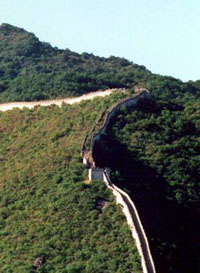
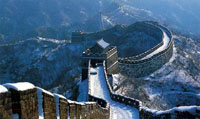
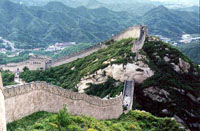
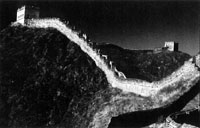
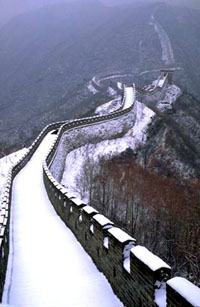
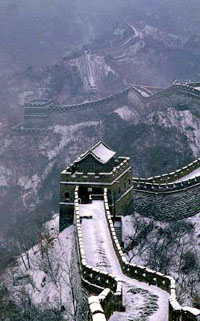
|


